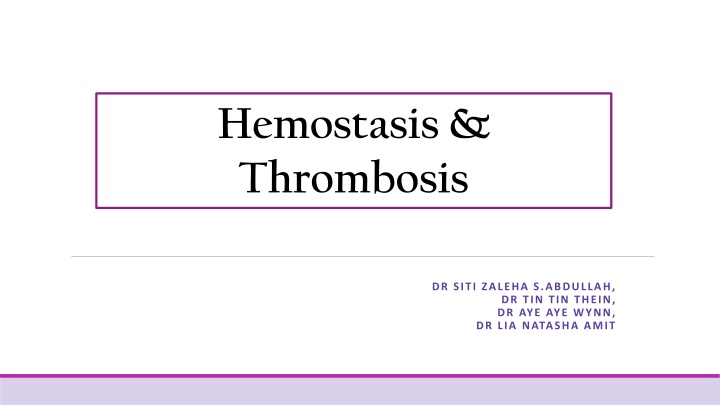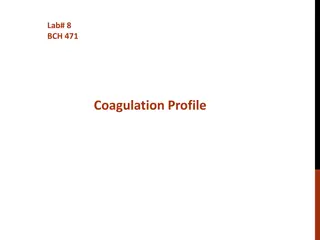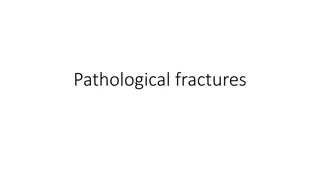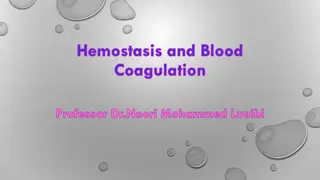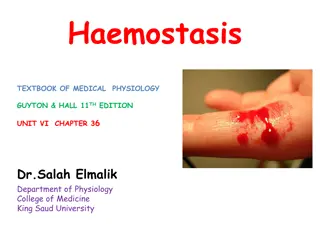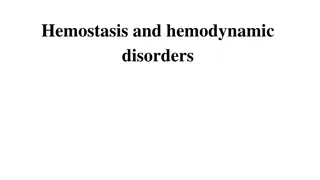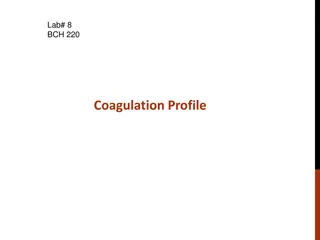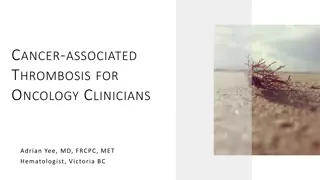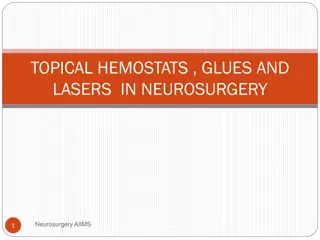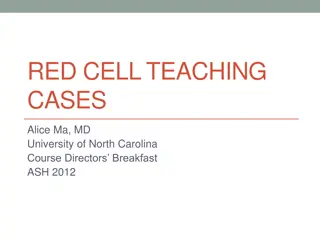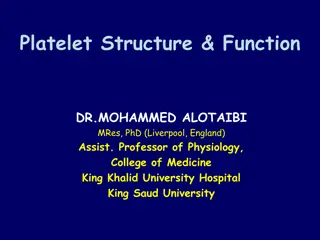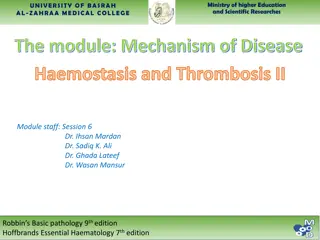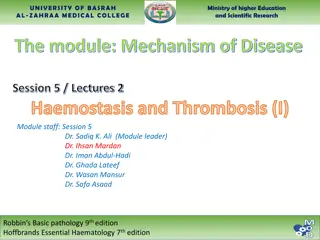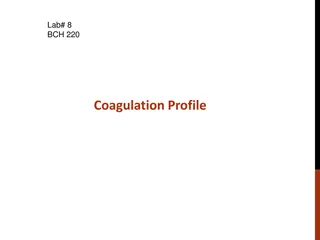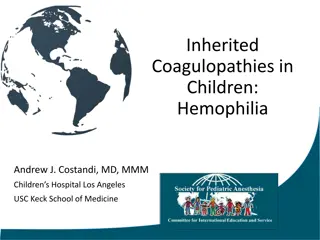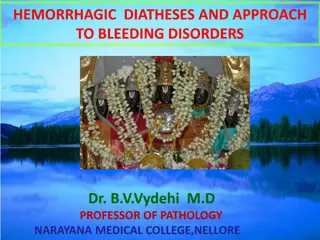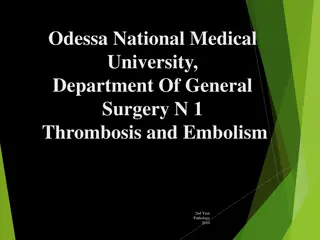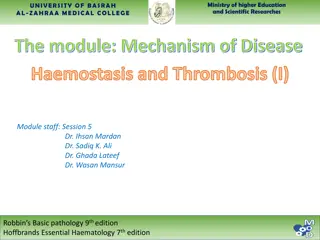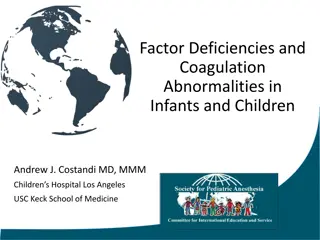Hemostasis & Thrombosis: Overview and Pathological Mechanisms
Normal hemostasis involves regulated processes to maintain blood in a fluid state while forming a hemostatic plug at injury sites. Thrombosis, the pathological counterpart, results in blood clot formation within intact vessels due to endothelial injury, abnormal blood flow, and hypercoagulability. Understanding these processes is crucial in managing thrombotic disorders.
Download Presentation

Please find below an Image/Link to download the presentation.
The content on the website is provided AS IS for your information and personal use only. It may not be sold, licensed, or shared on other websites without obtaining consent from the author.If you encounter any issues during the download, it is possible that the publisher has removed the file from their server.
You are allowed to download the files provided on this website for personal or commercial use, subject to the condition that they are used lawfully. All files are the property of their respective owners.
The content on the website is provided AS IS for your information and personal use only. It may not be sold, licensed, or shared on other websites without obtaining consent from the author.
E N D
Presentation Transcript
Hemostasis & Thrombosis DR SITI ZALEHA S.ABDULLAH, DR TIN TIN THEIN, DR AYE AYE WYNN, DR LIA NATASHA AMIT
OUTLINE OUTLINE Introduction Introduction Normal Haemostasis Normal Haemostasis Thrombosis Thrombosis Endothelial injury Endothelial injury Abnormal blood flow Abnormal blood flow Hypercoagulability Hypercoagulability Fate of thrombus Fate of thrombus
INTRODUCTION INTRODUCTION Hemostasis & Thrombosis Normal hemostasis comprises a series of regulated processes that maintain blood in a fluid , clot-free state in normal vessel while rapidly forming a localized hemostatic plug at the site of vascular injury. The pathologic counterpart of hemostasis is thrombosis, the formation of blood clot (thrombus) within intact vessels. Endothelial cells are central regulators of hemostasis; the balance between the anti- thrombotic and prothrombotic activities of endothelium determines whether thrombus formation, propagation, or dissolution occurs. Primary Hemostasis; vWF and Platelets Primary Hemostatic Plug Secondary Hemostasis; Clotting Factors Tertiary Hemostasis; Clot Resorption
Normal Haemostasis Once activated, coagulation cascade must be tightly restricted to the site of injury to prevent inappropriate and potentially dangerous clotting elsewhere in the vascular tree, by: 1. Restricting factor activation to sites of exposed phospholipids. 2. Natural anticoagulant Antithrombin Inhibit activity of thrombin and other serine proteases (Factor IXa, Xa, XIa, XIIa). Protein C and Protein S Vitamin K dependent proteins to inactivate cofactors Va and VIIIa. Tissue factor pathway inhibitor (TFPI) Inactivates factor Xa and TF-Factor VIIa complexes. 3. Fibrinolytic cascade Moderate the ultimate size of the clot. Largely carried out by plasmin (which breaks down fibrin and interfere with its polymerization).
Thrombosis ABNORMAL BLOOD FLOW The primary abnormalities that lead to intravascular thrombosis Virchow s triad : Endothelial injury THROMBOSIS Stasis or turbulent blood flow; chaotic blood flow contributes to arterial and cardiac thrombosis by causing endothelial injury or Dysfunction ENDOTHELIAL INJURY HYPERCOAGULABILITY Hypercoagulability of the blood
Thrombosis HYPERCOAGULABILITY ENDOTHELIAL INJURY Defined as an alterations of the coagulation pathways that predisposes effected person to thrombosis. Endothelial injury leading to platelet activation almost inevitably underlies thrombus formation in the heart and the arterial circulation. An important factor for venous thrombosis. severe endothelial injury may trigger thrombosis by exposing vWF and tissue factor. Contributes infrequently to arterial thrombosis. Primary (inherited) hypercoagulability is most often caused by mutations in the factor V and prothrombin genes. Ie; physical injury, infectious agents, abnormal blood flow, inflammatory mediators, metabolic abnormalities, such as hypercholesterolemia or homocystinemia, and toxins absorbed from cigarette smoke.
Abnormal blood flow Turbulencecontributes to arterial and cardiac thrombosis by causing endothelial injury or dysfunction, as well as by forming countercurrents that contribute to local stasis. Stasisis a major contributor in the development of venous thrombi. Promote endothelial activation, enhancing procoagulant activity and leukocyte adhesion, in part through flow-induced changes in the expression of adhesion molecules and pro-inflammatory factors Disrupt laminar flow and bring platelets into contact with the endothelium Prevent washout and dilution of activated clotting factors by fresh flowing blood and the inflow of clotting factor inhibitors
Fate of thrombus Propagation Thrombus enlarges through accumulation of additional platelets and fibrin. Embolization Thrombus dislodge and transported elsewhere in the vasculature. Dissolution Rapid shrinkage and dissolution of newly formed thrombus thrombus as a result of fibrinolysis. Organization and recanalization Older thrombi become organized by the ingrowth of endothelial cells, smooth muscle cells and fibroblast into fibrin rich thrombus.
